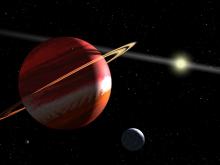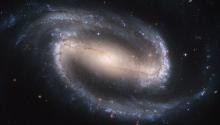Listen to today's episode of StarDate on the web the same day it airs in high-quality streaming audio without any extra ads or announcements. Choose a $8 one-month pass, or listen every day for a year for just $30.
You are here
The Footstool
Orion strides across the southern sky this evening. The hunter climbs into good view in the east and southeast shortly after nightfall. His brightest star, Rigel, stands to the right of his three-star belt.
If the hunter ever gets tired during his never-ending journey across the sky, he can always prop his feet up for a little rest. That’s because a “footstool” has been provided for him in the adjoining constellation Eridanus, the river. The stool is marked by the moderately bright star Cursa. Its name comes from an Arabic phrase that means “the footstool.”
For the most part, Cursa is unremarkable. It’s a few times bigger and heavier than the Sun, and a few dozen times brighter. It’s used up the original hydrogen fuel in its core, so it’s undergoing a series of changes. The changes will cause its core to get smaller and hotter, igniting the next round of nuclear fusion. As that happens, its outer layers will get bigger and cooler. That will make Cursa shine much brighter than it does now. It’ll also give the star a definite orange hue.
One remarkable thing did happen to the star more than three decades ago. For a couple of hours, it flared to more than 10 times its normal brightness. But it hasn’t repeated the flare-up, so astronomers can’t explain the footstool’s brief showiness.
Cursa stands just above Orion’s foot — bright blue-white Rigel — in early evening, ready to give the hunter a break in his journey across the night sky.
Script by Damond Benningfield




